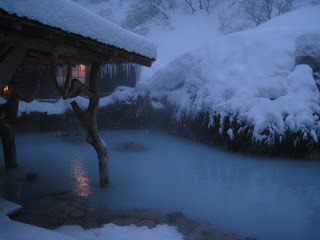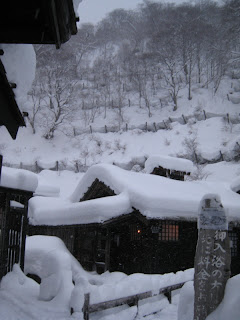Food is always on our mind, and we are continuously thinking about where and what to eat for lunch and dinner. On this leg of our trip, we were thinking about having lunch on the Shinkansen or in Tokyo when we left the Tsurunoyu Onsen at 8am to head back to Tokyo. When we got to the Tazawako Station in Akita that morning, we were told that the 10am train was not running due to snow near Akita City. Since we had to wait for a Shinkansen, our thoughts naturally turned to food.
By the time we were able to board the Shinkansen, it was around 11:30am. Crossing from west of the Ouu Mountain Range (奥羽山脈)to the east, going to Morioka City, all of the snow that had been the most dominant part of the landscape seemed to melt away. Cold air masses from the Asian continent dumps lots of snow on the western part of Tohoku and drys up when it reaches to eastern part. When we arrived in Morioka, it was a little strange to see so little snow.
Now that we were in Morioka with time between trains, how could we miss the opportunity to sample one of great noodle dishes of Morioka? With two hours til the next train, we bolted to the original Ja Ja Men shop, Pairon (白龍 ) near the Morioka Castle Ruins Park and City Hall. It was during a lunch time when we arrived, and the shop was filled with salarymen working nearby. It was a narrow, hole-in-the-wall, with tables and counter sporting only the necessary chopsticks and condiments. Salarymen were reading manga while they were waiting for their noodles.
We wasted no time ordering. Delivered just as quickly, our bowls of Ja Ja Men were filled with white udon-like noodles topped with cucumbers and a mountain of ground pork and a special local miso on top, accompanied by grated ginger and pickles. Noticing our cluelessness on how to eat it, the lady of the house came to the rescue and gave us a quick tutorial. Reaching for the condiments, she added vinegar, grated garlic, and sesame oil, and quickly mixed the noodles with the miso, cucumbers, and ginger.
It was amazing! Nothing seemingly special, yet so tasty, we still salivate when thinking about this unique dish. The miso with ground pork was in perfect harmony with the udon-like noodle, vinegar and oil. Many other salarymen came and went while we slowly savored each bite.
It wasn't over once we finished eating the noodles. The lady then came to our table, picked up a raw egg on the table, cracked it open, added it to the dish, and brought the dish over to a man at the counter who was cooking the noodle. He poured some hot water from noodle cooking pot into our bowls. Our Ja Ja Men became an egg soup that blended perfectly with the mix of noodle, miso, and pork remaining in the bottom of the bowl. We finished drinking the soup and were left with nothing but a squeaky clean, a self cleaned dish!
Pairon
5-15 Uchimaru, Morioka, Iwate Prefecture
Japan
Phone:019-624-2247


















































